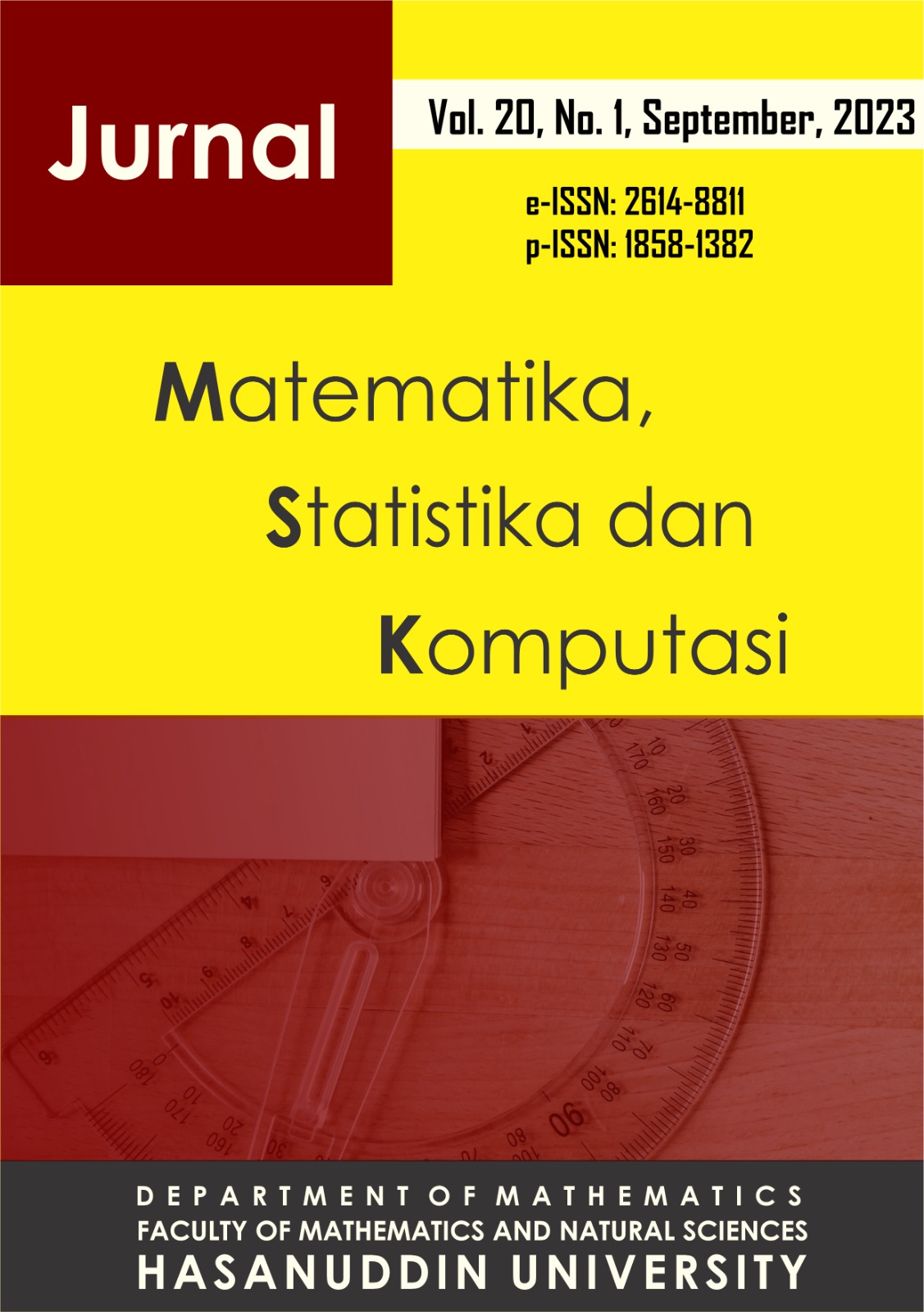Stability Analysis of the SIR-SI Model for Dengue Fever Transmission with Saturated Birth Rate
DOI:
https://doi.org/10.20956/j.v20i1.27746Keywords:
Dengue fever, Sensitivity analysis, SIR-SI modelAbstract
The SIR-SI mathematical model for the problem of dengue virus spread which has been discussed in previous studies has not involved the saturated birth rate of mosquito. This discussion aims to construct and analyze the SIR-SI model which involves competition factors in mosquito population growth so that the model used to predict the number of dengue virus infections becomes more realistic. In addition, sensitivity analysis and numerical simulations of the models that have been constructed are also discussed. The method used is a literature study using theories derived from reputable articles. The results of this discussion show that the existence of an equilibrium point and its stability depends on the basic reproduction number. If the basic reproduction number is less than one, the number of cases of dengue fever infection will decrease. However, if the basic reproduction number is more than one, the number of cases of dengue infection will not decrease and even tend to be constant at a certain number. The average parameter of bites carried out by one mosquito in all humans () is the most dominant in increasing the spread of dengue disease in humans. On the other hand, mosquitoes' natural death rate parameter () is the most dominant in reducing the spread of dengue fever in humans. This information provides input and evaluation to decision-makers in solving the problem of the spread of dengue fever.
References
Andraud, M., Hens, N. & Beutels, P., 2013. A simple periodic-forced model for dengue fitted to incidence data in Singapore. Mathematical Biosciences, vol. 244, no. 1, 22-28.
Alkhaldy, I., 2017. Modelling the association of dengue fever cases with temperature and relative humidity in Jeddah, Saudi Arabia-A generalised linear model with break-point analysis. Acta Tropica, vol. 168, 9-15.
Chimeh, M. K. & Richmond, P., 2018. Simulating heterogeneous behaviours in complex systems on GPUs. Simulation Modelling Practice and Theory, vol. 83, 3-17.
Esteva, L. & Vargas, C., 1998. Analysis of a dengue disease transmission model. Mathematical Biosciences, vol. 150, no. 2, 131-151.
Esteva, L. & Vargas, C., 1999. A model for dengue disease with variable human population. Journal of Mathematical Biology, vol. 38, no. 3, 220-240.
Esteva, L. & Vargas, C., 2003. Coexistence of different serotypes of dengue virus. Journal of Mathematical Biology, vol. 46, no. 1, 31-47.
Kermack, W. O. & McKendrick, A. G., 1991. Contributions to the mathematical theory of epidemics-I. Bulletin of Mathematical Biology, Vol. 53, 33-55.
Li, C. et al., 2017. Modeling and projection of dengue fever cases in Guangzhou based on variation of weather factors. Science of The Total Enviroment, vol. 8, No. 3, 605–606.
Li, Y., Guo, Z. & Xing, Y., 2020. Modeling Wolbachia Diffusion in Mosquito Populations by Discrete Competition Model. Discrete Dynamics in Nature and Society, vol. 2020, 1-11.
Liu-Helmersson, J., et al., 2014. Vectorial capacity of Aedes aegypti: Effects of temperature and implications for global dengue epidemic potential. PLoS One, vol. 9, no. 3, 1-10.
Marini, G. et al., 2017. The effect of interspecific competition on the temporal dynamics of Aedes albopictus and Culex pipiens. Parasites and Vectors, vol. 10, no. 1, 1-9.
Nur, W. et al., 2018. SIR Model Analysis for Transmission of Dengue Fever Disease with Climate Factors Using Lyapunov Function. Journal of Physics: Conference Series, vol. 1028, no. 1, 1-7.
Nuraini, N. et al., 2021. Climate-based dengue model in Semarang, Indonesia: Predictions and descriptive analysis. Infectious Disease. Modelling, vol. 6, 598-611.
Putra, P. S. & Nuraini, N., 2017. Modeling of dengue occurrences early warning involving temperature and rainfall factors. Asian Pacific Journal of Tropcal Disease, vol. 7, no. 7, 385-390.
Sanusi, W. et al., 2021. Analysis and Simulation of SIRS Model for Dengue Fever Transmission in South Sulawesi, Indonesia. Journal of Applied Mathematics, vol. 2021, 1-8.
Side, S. & Noorani, S. M., 2013. A SIR model for spread of dengue fever disease (simulation for South Sulawesi, Indonesia and Selangor, Malaysia). World Journal of Modelling and Simulation, vol. 9, no. 2, 96-105.
Side, S. et al., 2019. A SEIRS model analysis and simulation for dengue fever transmission. International Journal of Scientific and Technology Research, vol. 8, no. 10, 1048-1053.
Side, S. et al., 2016. Global stability of SIR and SEIR model for tuberculosis disease transmission with lyapunov function method. Asian Journal of Applied Sciences, vol. 9, no. 3, 87-96.
Williams, C., R., et al., 2015. Testing the impact of virus importation rates and future climate change on dengue activity in Malaysia using a mechanistic entomology and disease model. Epidemiology and Infection, vol. 143, no. 13, 2856–2864.
Yang, H. M. & Ferreira, C. P., 2008. Assessing the effects of vector control on dengue transmission. Applied Mathematics and Computation, vol. 198, no. 1, 401-413.
Downloads
Published
How to Cite
Issue
Section
License
Copyright (c) 2023 Author and publisher

This work is licensed under a Creative Commons Attribution 4.0 International License.

This work is licensed under a Creative Commons Attribution 4.0 International License.
Jurnal Matematika, Statistika dan Komputasi is an Open Access journal, all articles are distributed under the terms of the Creative Commons Attribution License, allowing third parties to copy and redistribute the material in any medium or format, transform, and build upon the material, provided the original work is properly cited and states its license. This license allows authors and readers to use all articles, data sets, graphics and appendices in data mining applications, search engines, web sites, blogs and other platforms by providing appropriate reference.







